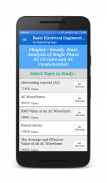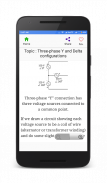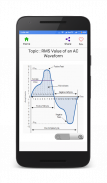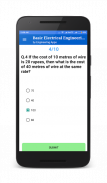










Basic Electrical Engineering-1

Basic Electrical Engineering-1의 설명
This unique Free application is for all students across the world. It covers 108 topics of Basic Electrical in detail. These 108 topics are divided in 5 units.
Each topic is around 600 words and is complete with diagrams, equations and other forms of graphical representations along with simple text explaining the concept in detail.
This USP of this application is "ultra-portability". Students can access the content on-the-go from anywhere they like.
Basically, each topic is like a detailed flash card and will make the lives of students simpler and easier.
Few topics Covered in this application are:
1. Introduction of electrical engineering
2. Voltage and current
3. Electric Potential and Voltage
4. Conductors and Insulators
5. Conventional versus electron flow
6. Ohm's Law
7. Kirchoff's Voltage Law (KVL)
8. Kirchoff's Current Law (KCL)
9. Polarity of voltage drops
10. Branch current method
11. Mesh current method
12. Introduction to network theorems
13. Thevenin's Theorem
14. Norton's Theorem
15. Maximum Power Transfer Theorem
16. star-delta transformation
17. Source Transformation
18. voltage and current sources
19. loop and nodal methods of analysis
20. Unilateral and Bilateral elements
21. Active and passive elements
22. alternating current (AC)
23. AC Waveforms
24. The Average and Effective Value of an AC Waveform
25. RMS Value of an AC Waveform
26. Generation of Sinusoidal (AC) Voltage Waveform
27. Concept of Phasor
28. Phase Difference
29. The Cosine Waveform
30. Representation of Sinusoidal Signal by a Phasor
31. Phasor representation of Voltage and Current
32. AC inductor circuits
33. Series resistor-inductor circuits: Impedance
34. Inductor quirks
35. Review of Resistance, Reactance, and Impedance
36. Series R, L, and C
37. Parallel R, L, and C
38. Series-parallel R, L, and C
39. Susceptance and Admittance
40. Simple parallel (tank circuit) resonance
41. Simple series resonance
42. Power in AC Circuits
43. Power Factor
44. Power Factor Correction
45. Quality Factor and Bandwidth of a Resonant Circuit
46. Generation of Three-phase Balanced Voltages
47. Three-Phase, Four-Wire System
48. Wye and delta configurations
49. Distinction between line and phase voltages, and line and phase currents
50. Power in balanced three-phase circuits
51. Phase rotation
52. Three-phase Y and Delta configurations
53. Measurement of Power in Three phase circuit
54. Introduction of measuring instruments
55. Various forces/torques required in measuring instruments
56. General Theory Permanent Magnet Moving Coil (PMMC) Instruments
57. Working Principles of PMMC
58. A multi-range ammeters
59. Multi-range voltmeter
60. Basic principle operation of Moving-iron Instruments
61. Construction of Moving-iron Instruments
62. Shunts and Multipliers for MI instruments
63. Dynamometer type Wattmeter
64. Introduction to Power System
65. POWER TRANSMISSION AND DISTRIBUTION
66. Magnetic Circuit
67. B-H Characteristics
68. Analysis of Series magnetic circuit
69. Analysis of series-parallel magnetic circuit
70. Different laws for calculating magnetic field-Biot-Savart law
71. Amperes circuital law
72. Reluctance & permeance
73. Introduction of Eddy Current & Hysteresis Losses
74. Eddy current
75. Derivation of an expression for eddy current loss in a thin plate
76. Hysteresis Loss
77. Hysteresis loss & loop area
78. Steinmetzs empirical formula for hysteresis loss
79. Inductor
80. Force between two opposite faces of the core across an air gap
81. ideal transformer
82. Practical transformer
83. equivalent circuit
84. Efficiency of transformer
85. Auto-Transformer
86. Introduction of D.C Machines
87. D.C machine Armature Winding
88. EMF Equation
89. Torque equation
90. Generator types & Characteristics
91. Characteristics of a separately excited generator
92. Characteristics of a shunt generator
93. Load characteristic of shunt generator
94. Single-phase Induction Motor
All topics are not listed because of character limitations set by the Play Store.이 독특한 무료 응용 프로그램은 전세계 모든 학생들을위한 것입니다. 그것은 세부 사항에 기본 전기의 108 주제를 다룹니다. 이 108 주제는 5 단위로 분할된다.
각 주제는 약 600 단어이고 상세하게 개념을 설명하는 간단한 텍스트와 함께 다이어그램, 방정식과 그래픽 표현의 다른 형태의 완전하다.
이 응용 프로그램의이 USP는 "매우 이식성"입니다. 학생들은 어디서나 그들이 원하는에서 온 이동 콘텐츠에 액세스 할 수 있습니다.
기본적으로, 각 항목에 대한 자세한 플래시 카드처럼 학생들의 생활을 간단하고 쉽게 할 것이다.
이 응용 프로그램에서 다루지 몇 가지 주제는 다음과 같습니다 :
1. 전기 공학 소개
2. 전압 및 전류
3. 전위와 전압
4. 도체와 절연체
5. 전자 흐름 대 종래
6. 옴의 법칙
7. 키르히 호프의 전압 법칙 (KVL)
8. 키르히 호프의 전류 법칙 (KCL)
9. 전압 강하의 극성
10. 현재의 방법을 분기
11. 현재 메서드 메쉬
12. 정리를 네트워크에 소개
13. 테브난의 정리
14. 노턴의 정리
15. 최대 전력 전송 정리
16. 스타 - 델타 변환
17. 소스 변환
18. 전압 및 전류 소스
19. 루프 및 분석 마디 방법
20. 일방적 양자 간 요소
21. 능동 및 수동 소자
22. 교류 전류 (AC)
23. AC 파형
24. AC 파형의 평균치와 실효치
25. AC 파형의 RMS 값
26. 사인 (AC) 전압 파형의 생성
27. 페이저의 개념
28. 위상차
29. 코사인 파형
30. 페이저에 의한 정현파 신호의 표현
31. 전압 및 전류의 페이저 표현
32. AC 인덕터 회로
33. 시리즈 저항, 인덕터 회로 : 임피던스
34. 인덕터의 단점
35. 저항, 리액턴스, 임피던스의 검토
36. 시리즈의 R, L, C를
37. 병렬 R, L, C를
38. 시리즈 병렬 R, L, C를
39. 서셉 턴스 및 입장
40. 단순 병렬 (탱크 회로) 공명
41. 간단한 직렬 공진
42. AC 회로에있는 전원
43. 역률
44. 역률 보정
45. 공진 회로의 품질 계수 및 대역폭
46. 삼상 평형 전압의 생성
47. 3 상 4 선식 시스템
48. 와이 델타 구성
49. 라인 및 위상 전압, 라인 및 위상 전류 간의 차이
50. 평형 삼상 회로에서 전력
51. 위상 회전
52. 삼상 Y 델타 구성
53. 삼상 회로의 전력 측정
54. 측정 기기의 도입
55. 측정 기기에 필요한 다양한 힘 / 토크
56. 일반 이론 영구 자석은 코일 (PMMC) 악기를 이동
57. PMMC의 작동 원리
58. 다중 범위 전류계
59. 다중 범위 전압계
60. 이동 철 악기의 기본 작동 원리
61. 이동 철 악기의 건설
62. MI 장비에 대한 션트 및 멀티 플라이어
63. 동력계 형 전력계
64. 전원 시스템 소개
65. 송배전
66. 자기 회로
67. B-H 특성
68. 시리즈 자기 회로의 분석
69. 직 병렬 자기 회로의 해석
70. 자기장 - 비오 - 사 바르의 법칙을 계산하기위한 다른 법률
71. circuital 법을 A
72. 자기 저항 및 투과도
73. 에디 전류 및 히스테리시스 손실 소개
74. 와전류
75. 얇은 판의 와전류 손실에 대한 식의 유도
76. 히스테리시스 손실
77. 히스테리시스 손실 및 루프 영역
78. 히스테리시스 손실에 대한 실험식을 Steinmetzs
79. 인덕터
80. 에어 갭을 가로 질러 코어의 마주 보는 두면 사이 포스
81. 이상적인 트랜스포머
82. 실제 변압기
83. 등가 회로
84. 변압기의 효율
85. 자동 변압기
86. D.C 기계 소개
87. 권선 D.C 기계 전기자
88. EMF 식
89. 토크 방정식
90. 발전기의 종류 및 특성
91. 타 여자 발전기의 특성
92. 션트 발생기의 특성
93. 션트 발전기의 부하 특성
94. 단상 유도 전동기
모든 주제 때문에 플레이 스토어에 의해 설정된 문자 제한으로 나열되지 않습니다.


























